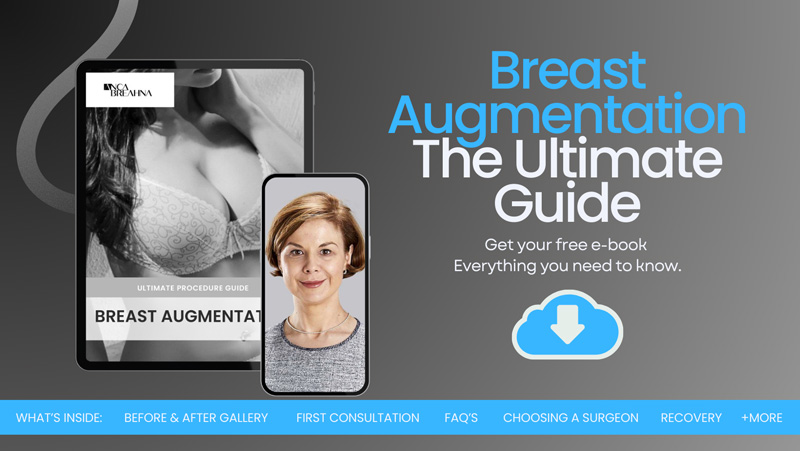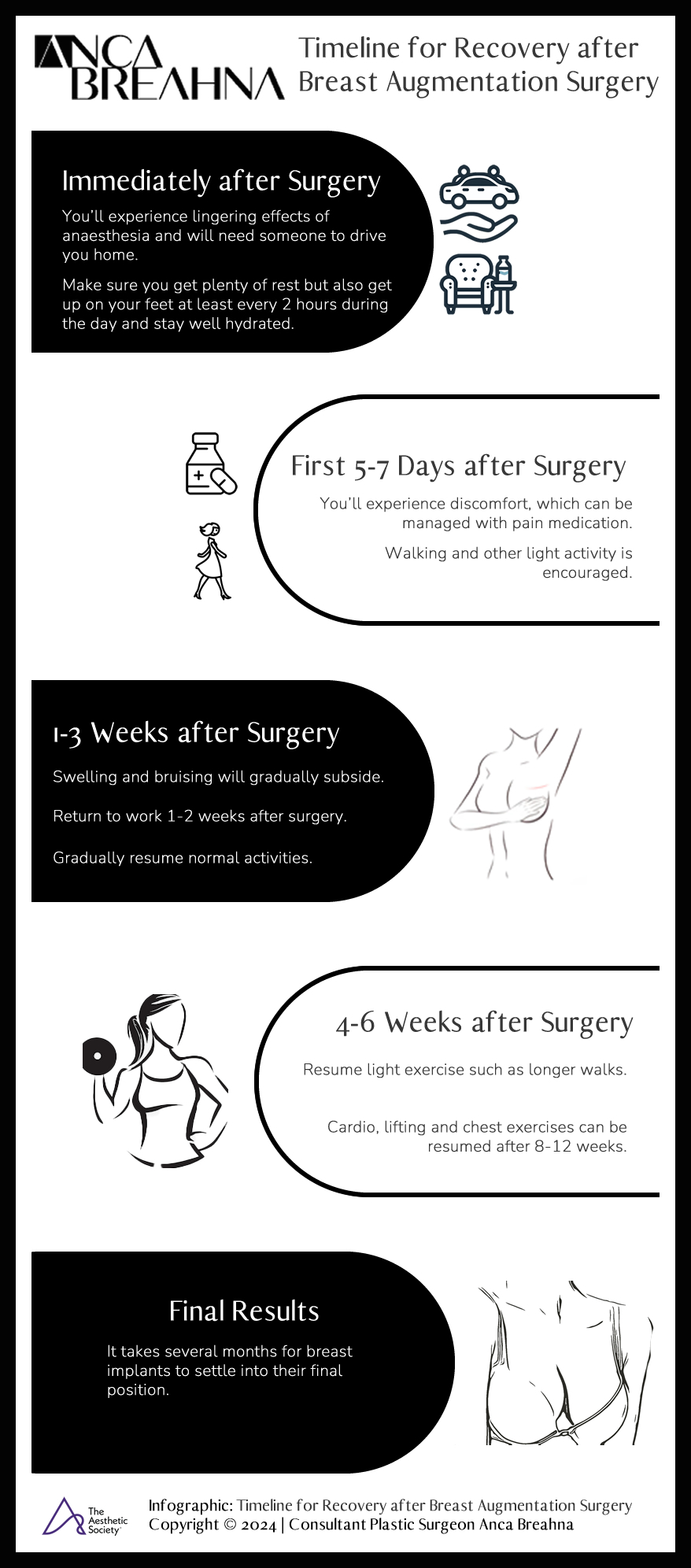
What to Expect During Recovery after Breast Augmentation
Breast augmentation, commonly known as a ‘boob job’, is a popular cosmetic surgery procedure in the UK and the rest of the world. It involves enhancing the size and shape of the breasts, typically through implants. Whether you’re considering breast augmentation for personal reasons or to address physical changes after events like pregnancy or weight loss, it’s a significant decision and understanding the recovery timeline is essential. In this blog, Chester Consultant Plastic Surgeon Anca Breahna aims to guide you through each stage of the recovery timeline after breast augmentation, offering practical advice and insights to help you manage your expectations and prepare effectively.
Download the Breast Augmentation Guide

The First 24 Hours Post-Surgery
The initial 24 hours after your surgery are particularly important in setting the tone for your recovery. During this time, your body starts to heal and adapt to the changes.
Right after your surgery, you’ll find yourself in the recovery room where the medical team will monitor your vital signs and ensure you’re responding well following the procedure. It’s common to feel groggy and disoriented as the anaesthesia wears off, so don’t be alarmed. This is a normal response as your body begins to recover.
You’ll be given detailed instructions on how to care for your breasts post-surgery. These guidelines are essential for preventing infection and ensuring proper healing. You might have drains in place to remove excess fluid from the surgical site, and the staff will explain how to manage these if they’re still in place when you go home.
It’s natural to experience some pain and discomfort during the first 24 hours. The extent of this will vary based on your individual pain threshold and the specifics of your surgery. Anca will prescribe pain medication, which should be taken as directed to manage any discomfort.
Remember, managing pain is not just about taking medication. Simple actions like keeping your upper body elevated and using ice packs can significantly reduce swelling and discomfort. It’s key to follow these instructions precisely, as they are designed to support your body’s healing process.
Monitoring for Any Complications
During the first day, it’s essential to watch for signs of complications. While serious issues are rare, being vigilant can help catch any problems early. Look out for symptoms such as excessive swelling, redness, or discharge from the incision sites. A fever or severe pain can also indicate a problem and should prompt an immediate call to your surgeon.
Anca will provide specific signs to watch for, which may include unusual changes in breast shape, size, or any new, unexpected symptoms. Should you notice anything concerning, don’t hesitate to contact your medical team. It’s better to be cautious and get reassurance than to overlook a potential problem.
Week 1 after Breast Augmentation
The first week following your surgery is a period of significant healing and adjustment. It’s during this time that your body starts to acclimatise to the changes, and it’s important for you to understand how to best support this process. Let’s explore what you should expect and how to manage this crucial initial recovery phase:
Physical Limitations and Care
During the first week post-surgery, your body is still quite tender and healing. It’s important to give yourself the time to rest and recover. You’ll likely feel tired, and that’s completely normal – your body is using a lot of energy to heal.
You should avoid lifting anything heavy or engaging in strenuous activities that could strain your chest muscles. This means no heavy lifting, vigorous exercise, or anything that might put unnecessary pressure on your chest area. It’s also advisable to sleep on your back or propped up to avoid putting pressure on your breasts, which can help reduce swelling and discomfort.
Even simple tasks like raising your arms or pulling clothes over your head might be challenging at first. You may need to adjust your daily routine to accommodate these temporary limitations. Don’t hesitate to ask for help from friends or family members with tasks that are difficult or uncomfortable for you to do alone.
Managing Pain and Swelling
Pain and swelling are a normal part of the healing process, and managing them effectively is key to a comfortable recovery. You’ll likely be prescribed pain medication, and it’s important to take it as directed by Anca. This will help keep your discomfort to a manageable level and allow you to rest more comfortably.
Swelling is also common and can be managed with gentle care. Using ice packs can be beneficial, but remember to wrap them in a cloth to avoid direct contact with your skin. Wear any compression garments or special bras Anca provided or recommended. These garments are designed to support your new breast shape and help reduce swelling by applying gentle pressure to the area.
Remember, while it’s important to manage pain and swelling, it’s equally important to monitor your body for any signs of unusual pain or swelling, which could indicate a complication. If you notice anything out of the ordinary, don’t hesitate to contact your medical team.
Importance of Follow-Up Consultations after Breast Augmentation
Your first follow-up consultation is scheduled about a week after your surgery. This appointment is an important opportunity for Anca to check on your healing progress, assess how well you’re managing pain and swelling, and ensure there are no signs of complications.
This is also your chance to ask any questions you might have about your recovery, discuss any concerns, and get clarity on what to expect in the coming weeks. It’s important to attend these appointments, even if you feel like you’re healing well, as Anca can provide insights and advice that are crucial for your ongoing recovery.
Weeks 2 to 4 after Breast Augmentation Surgery
As you progress into the second to fourth weeks after your breast augmentation, you’ll likely notice a significant improvement in how you feel and move. This period is marked by a gradual shift back towards your normal routine, but it still requires a thoughtful approach to ensure your body continues to heal properly. Let’s get into how you can manage this phase effectively:
Gradual Return to Daily Activities
By the second week, the initial discomfort and fatigue start to diminish. You might feel ready to take on more activities, but it’s important to reintroduce them gradually. Listen to your body and understand its limits – pushing too hard too soon can set back your recovery.
At this stage, you might feel up to doing light household chores, short walks, and perhaps even returning to work, especially if your job isn’t physically demanding. However, it’s still advisable to steer clear of heavy lifting or high-impact activities. These could put undue pressure on your healing tissues and potentially lead to complications.
In terms of mobility, you’ll likely find it easier to move around, and simple tasks that were challenging in the first week might now be more manageable. This improvement is a positive sign, but remember, just because you can do something doesn’t mean you should. Keep prioritising your body’s need for rest and gradual healing.
Continuing Care and Precautions
Even as you start feeling better, continuing with proper care and precautions is essential. Keep wearing your supportive garments as advised by Anca, as they play a significant role in shaping and supporting your new contours.
Swelling should be decreasing, but it can still be present to some degree. Continue to use ice packs as needed and keep an eye out for any unusual changes in swelling or discomfort. If anything seems out of the ordinary, don’t hesitate to contact your plastic surgeon.
This phase is also a time to keep your incisions clean and well-cared for. Follow any specific instructions Anca has given you regarding wound care. Proper care of your incision sites is important for reducing the risk of infection and ensuring that your scars heal as well as possible.
Month 1 and Beyond after Breast Augmentation
Reaching the one-month mark after your breast augmentation is a significant milestone. This phase marks the transition from immediate post-operative care to long-term maintenance and adaptation. It’s a time for both your body and mind to adjust to the changes and settle into a new normal.
Physical Adjustments
By now, most of the swelling and bruising should have subsided, and you’re likely getting used to the new shape and feel of your breasts. It’s important to continue monitoring your body for any changes or signs of complications, even though they are less likely at this stage.
Your scars will begin to mature and fade, although they will not disappear completely. If you have concerns about scarring, discuss them with Anca. She might recommend scar treatment options such as silicone sheets or gels, which can help in making the scars less noticeable.
It’s also common to experience changes in sensation around your breasts and nipples during this time. For some, sensitivity increases, while others may experience numbness. These sensory changes are usually temporary and tend to resolve over time.
Resuming Exercise and Physically Intense Activities
Resuming exercise is an important aspect of your long-term recovery and overall health. However, it’s essential to reintroduce physical activities gradually:
- Light Exercises: Start with light exercises such as walking or gentle yoga. These activities can help maintain your fitness without placing undue stress on your body
- Building up Intensity: As you feel more comfortable, you can slowly increase the intensity of your workouts. Always listen to your body and avoid pushing too hard, too quickly. Activities that involve bouncing or high impact should be approached with caution and only once you have the go-ahead from Anca
- Strength Training: When it comes to strength training, particularly exercises that target the chest, be cautious. Start with lighter weights and gradually increase as your comfort and strength improve. Always prioritise proper form to avoid strain
Regular Medical Check-Ups and Mammograms
Regular follow-ups with Anca are important to ensure that your breasts are healing as expected. During these appointments, she can address any concerns you may have and provide guidance on any ongoing care.
Mammograms
Mammograms play a crucial role in monitoring your breast health, especially after augmentation. Discuss with Anca the appropriate schedule for these screenings. It’s important to inform the radiologist about your implants, as they may need to use special techniques for a more effective mammogram.
Ongoing Monitoring
Keep an eye out for any unusual changes in your breasts, such as pain, lumps, swelling, or changes in shape or size. If you notice anything concerning, don’t delay in contacting your healthcare provider.
FAQs about Recovery Timeline after Breast Augmentation
How can I ensure the best possible scar healing after breast augmentation?
- Scar healing can vary depending on individual factors such as skin type and the body’s natural healing process. To promote better scar healing, it’s recommended to follow Anca’s advice on scar care, which may include using silicone scar sheets or gels. Keeping the scar protected from the sun is also important, as UV exposure can darken scars. Additionally, maintaining a healthy diet and staying hydrated can support your body’s natural healing processes.
What should I wear during the recovery period?
- During the initial weeks post-surgery, wearing a supportive surgical bra is advised. This bra provides the necessary support to your breasts, helps with swelling, and maintains the position of the implants. After the initial recovery phase, Anca will guide you on when it’s appropriate to switch to regular bras. It’s generally recommended to avoid underwire bras until your surgeon advises that it’s safe to do so, as they can irritate the incision sites.
Can I sleep on my side after breast augmentation?
- In the initial weeks following surgery, it’s usually advised to sleep on your back to avoid putting pressure on your breasts. This position helps in reducing swelling and discomfort. Anca will let you know when it’s safe to start sleeping on your side, but this isn’t recommended until you are well into the healing process.
When can I resume driving after breast augmentation?
- The ability to resume driving depends on several factors, including the type of anaesthesia used, your overall health, and how you feel. Most people are able to start driving again within a week or two post-surgery, but it’s important to wait until you are off prescription pain medication and feel confident that you can perform the necessary movements without discomfort or restrictions.
Are there any dietary recommendations or restrictions during the recovery process?
- A balanced diet is key to supporting your body’s healing process. Focus on foods rich in vitamins, minerals, and protein, which can aid in tissue repair and overall recovery. Staying hydrated is also essential. It’s advisable to limit your intake of sodium to reduce swelling, and to avoid alcohol, especially if you’re taking prescription pain medication.
Further Reading about Breast Augmentation with Consultant Plastic Surgeon Anca Breahna
- Read more about Breast Augmentation with Mentor Breast Implants
- Read more about Breast Augmentation Trends: What’s Popular in 2024?
- Read more about What is Breast Augmentation Surgery?
- Read more about When Do Breasts Stop Growing
- Read more about Breast Enlargement Pills and Creams
- Read more about Natural Boob Job – Autologous Fat Transfer to the Breasts
- Read more about When Can I Exercise after Breast Augmentation Surgery?
- Read more about Top 10 Benefits of Wearing a Compression Garment after Breast Implant Surgery
- Read more about 10 Myths Busted about Breast Augmentation and Breastfeeding
- Read more about Preparing for Breast Augmentation: A Checklist
- Read more about How Alcohol Affects Plastic Surgery Results
- Read more about When is a Good Time to Get Breast Implants?
Medical References about Breast Augmentation
- Breast Augmentation – American Society of Plastic Surgeons
- Breast Augmentation – Mayo Clinic
- Breast Implants – Web MD
- How Long Is the Recovery for A Breast Augmentation? – American Society of Plastic Surgeons
- Breast Enlargement (implants) – NHS



 Ms Anca Breahna, PhD, MSc, FEBOPRAS, FRCS (Plast) is a highly regarded Consultant Plastic Surgeon specialising in the field of Aesthetic and Reconstructive Plastic Surgery. Anca performs a range of
Ms Anca Breahna, PhD, MSc, FEBOPRAS, FRCS (Plast) is a highly regarded Consultant Plastic Surgeon specialising in the field of Aesthetic and Reconstructive Plastic Surgery. Anca performs a range of 